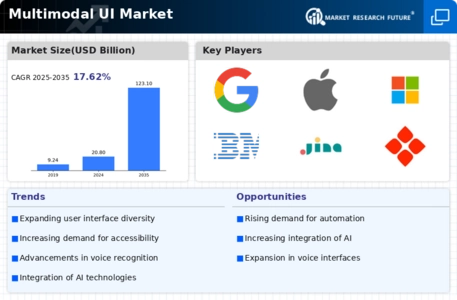Top Industry Leaders in the Multimodal UI Market

Competitive Landscape of the Multimodal UI Market:
The Multimodal User Interface (MMUI) market is experiencing explosive growth, driven by the convergence of voice, touch, gesture, and other interaction methods. This burgeoning ecosystem presents a dynamic landscape for established and emerging players, each vying for market share through diverse strategies and unique strengths. Understanding this competitive terrain is crucial for navigating the opportunities and challenges of this transformative market.
Key Players:
- Amazon
- Apple
- Microsoft
- Leap Motion
- IBM
- Jina AI
- Appen
- OpenAI
- Siemens
Market Share Analysis:
Factors influencing market share in the MUI landscape are multifaceted and constantly evolving:
- Technology Leadership: Superior AI algorithms, NLP accuracy, and robust gesture recognition capabilities are crucial differentiators. Constant innovation and investment in R&D are essential to stay ahead of the curve.
- User Experience: Seamless integration, intuitive interaction patterns, and context-aware adaptability are key to user satisfaction. Companies that prioritize user-centric design and personalization will gain an edge.
- Ecosystem Compatibility: Openness and interoperability across platforms and devices are critical for wide adoption. Partnerships and collaborations play a vital role in expanding reach and fostering developer communities.
- Industry-Specific Solutions: Tailoring MUI solutions to specific industry needs, such as healthcare data entry or automotive in-car interaction, creates differentiated value propositions and attracts niche market segments.
- Pricing Strategy: Cost-effective solutions cater to budget-conscious consumers, while premium offerings with advanced features target high-end users. Finding the right balance between affordability and value is crucial.
New and Emerging Trends:
The MUI market is constantly evolving, with several exciting trends shaping its future:
- Multimodal Fusion: Combining multiple interaction modalities, such as voice and gesture, is creating richer and more intuitive user experiences. This requires advanced data fusion algorithms and context-aware processing.
- Affective Computing: Understanding and responding to user emotions through facial expressions, voice tone, and other biometric data is paving the way for personalized and empathetic MUI interactions.
- Augmented and Virtual Reality (AR/VR): Integrating MUI with AR/VR environments is creating immersive and interactive experiences, particularly relevant for gaming, entertainment, and education.
- Ambient Computing: Seamless integration of MUI into smart homes and workplaces is blurring the lines between physical and digital interactions. This requires robust security and privacy considerations.
Current Investment Trends:
Companies across the MUI landscape are actively investing in these emerging trends:
- AI and Machine Learning: NLP, computer vision, and deep learning algorithms are fueling advancements in speech recognition, gesture recognition, and context awareness.
- Hardware Integration: Collaborations between MUI software developers and hardware manufacturers are leading to more specialized devices with dedicated MUI capabilities.
- Open-source Platforms: Fostering open-source MUI platforms and toolkits is accelerating innovation and attracting developer communities.
- Data Security and Privacy: Building secure and privacy-conscious MUI solutions is becoming paramount as user data collection and processing increase.
Latest Company Updates:
Jan 10, 2024, Microsoft unveils Project Silica, a multimodal UI prototype that utilizes eye tracking, voice commands, and hand gestures for a more natural and immersive human-computer interaction.
Dec 22, 2023, Google AI introduces "Coqui," a multi-modal conversational AI model trained on 3D virtual worlds, enabling richer interactions with embodied AI agents.

